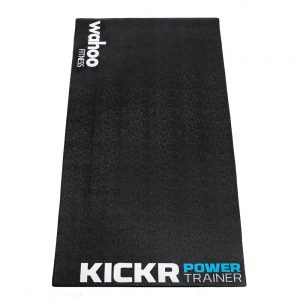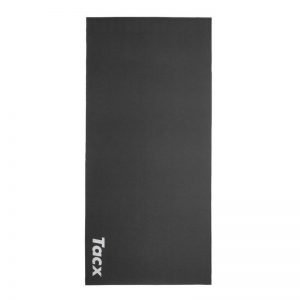The 8 Best Bike Trainer Mats in 2020
When it comes to indoor training, there’s no better investment than a good quality trainer mat. The right mat for your trainer can not only save you a lot of hassle, but it can make your ride more enjoyable and your workout more rewarding.
You’d probably be asking,
- Why would I need a mat made specifically for this?
- Aren’t all the mats the same?
Well, not quite.
On this page, I’ll discuss why you need a trainer-specific mat, what to look for, and share with you some of my favorites.
A Quick Glance : Our Favorite Mats for Indoor Bike Trainers
Value for Money Picks
AmazonBasics
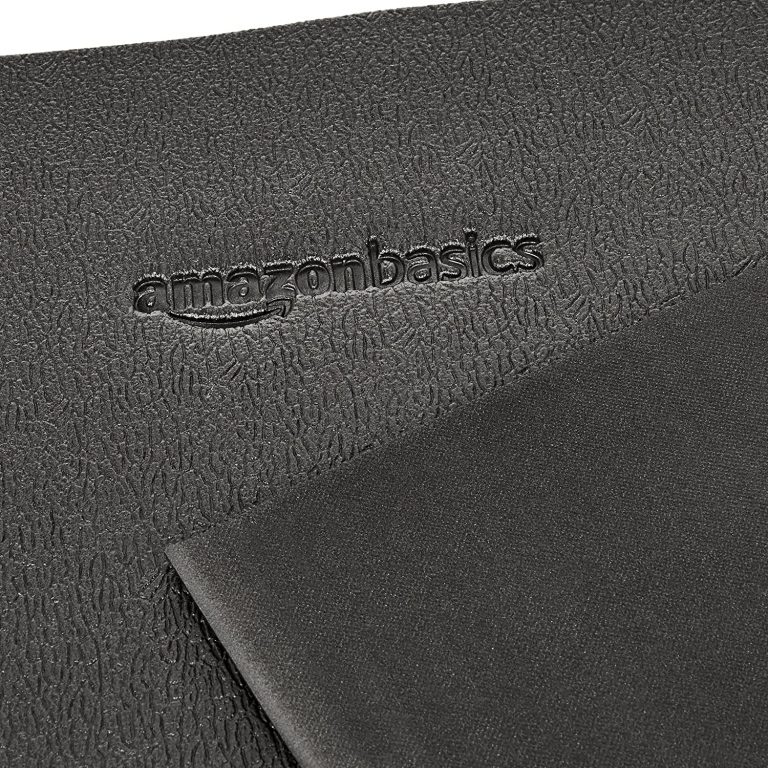
Answering the call for good quality essentials, this mat from Amazon offers the best value for those starting out or with less demanding routines.
The thick, resilient PVC material provides a solid, firm foundation for indoor trainers, standing up to pressure while protecting your floor and equipment.
At 30″ x 72″, it’s large enough to provide coverage to most trainers without taking up too much space. Plus, in a calm, neutral black, it blends into home gyms and other environments smoothly.
- Pros : Excellent choice for those on a budget. Wide dimensions can accommodate larger trainers.
- Cons : Material doesn’t absorb vibrations as efficiently as others.
Saris
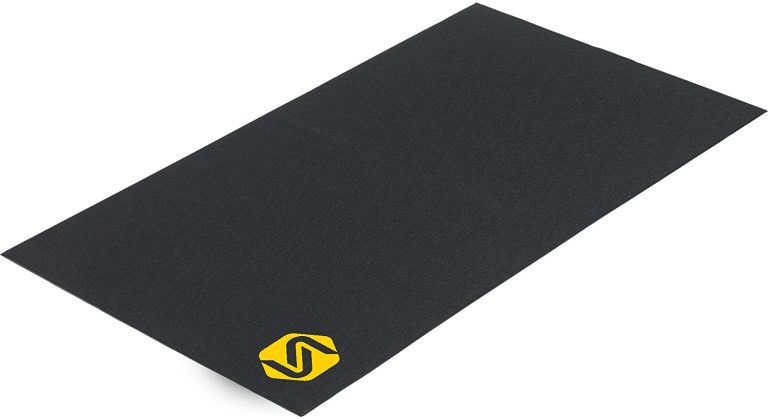
Saris, based in Madison, Wisconsin, is a company that focuses on making cycling accessible and popular, and their trainer mat is a definite step in that direction.
Covering all of your basic needs, this sturdy mat is constructed from durable material that grips the floor firmly. This stops you from creeping across the floor while on your trainer, as well as reducing scuffs and streaks.
- Pros : Made from durable, grippy materials with excellent vibration absorption properties.
- Cons : Can get slick and slippery when it’s wet.
High Quality & Heavy Duty Picks
Wahoo
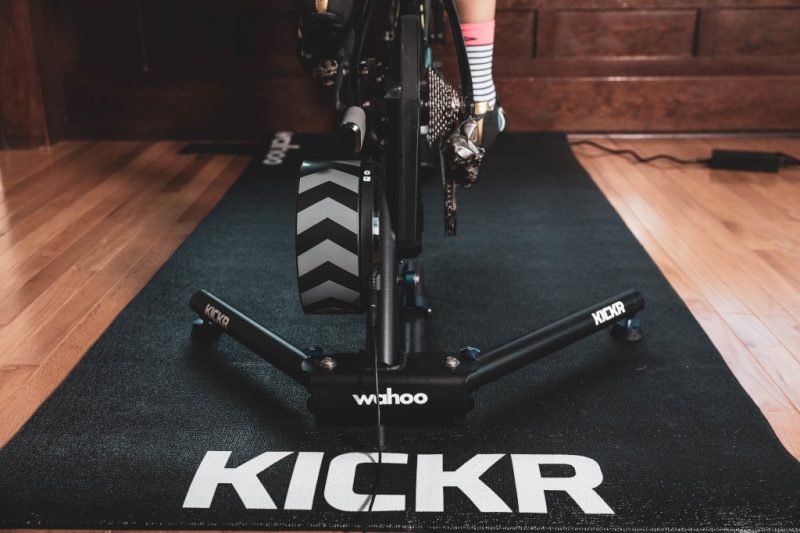
Of particular interest to loyalists of the leading indoor bike trainer Wahoo, the Kickr floor mat shows just how much thought can be put into something as simple as a mat.
The PVC material is unusually thick at 0.24″, and the beveled edges reduce the risk of tripping as well as unsightly tearing and fraying. Adding to the great features is the water-resistant material, protecting you from slipping on water or sweat.
Finally, that quarter of an inch helps cut down on noise and vibration, making your ride more pleasant for everyone at home.
- Pros : Very thick and durable. Absorbs noise and vibrations well.
- Cons : Be prepared to pay a premium.
Elite
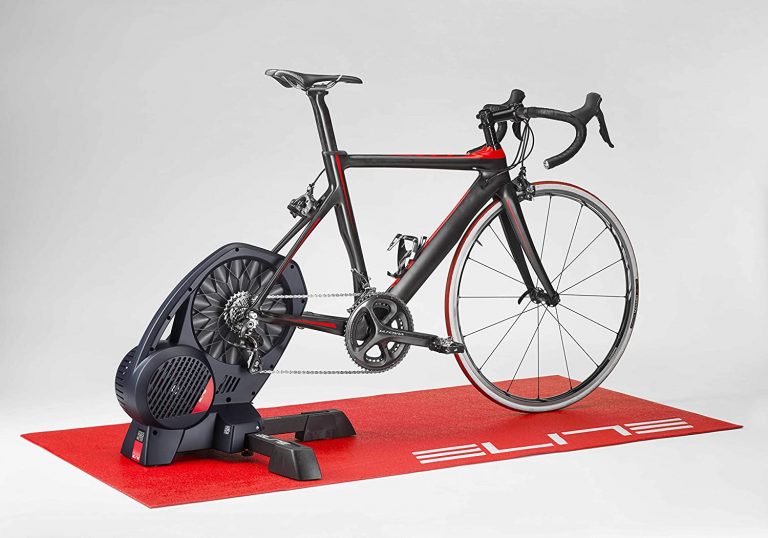
Italian firm Elite has spent the last 40 years perfecting their range of cycling accessories, and they’ve shown no sign of slowing down with indoor training. Their training mat wins the prize for best design.
Although it’s made from durable foam rubber, it is for those who want a firm surface with little give. It’s appropriate for any indoor trainer, but considering its sizeable 70″ x 35″, it’s an especially good choice for heavier or larger footprint trainers.
- Pros : Ideal for larger and heavier trainers. Comes with a 2-year manufacturer warranty.
- Cons : Red color might not suit some.
SuperMats
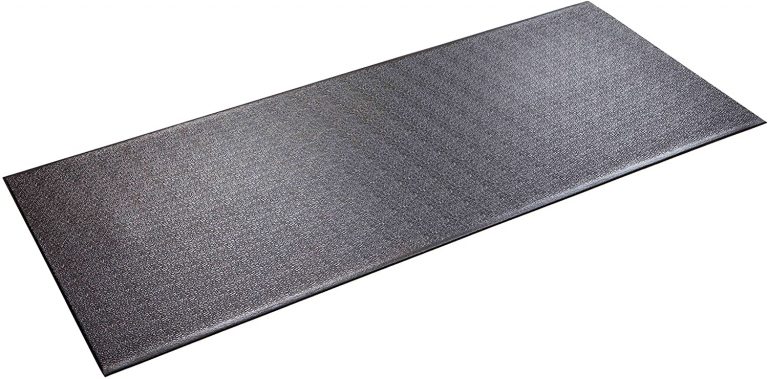
From Minnesota-based SuperMats, a company that focuses only on high-quality mats, you can expect a lot from this one. It’s designed to be the best for heavy-duty use.
Made from a specially formulated, extremely tough PVC, nothing has been left to chance with this mat for equipment wear, scratches, scuffs, or dirt.
It works most effectively on smooth surfaces like concrete or linoleum, where its noise-dampening and cleanliness-enhancing properties can be enjoyed more fully.
- Pros : Designed for heavy-duty usage in mind. Material is easy to wipe clean.
- Cons : Only works well on concrete surfaces.
Easy to Roll for Storage Picks
Tacx
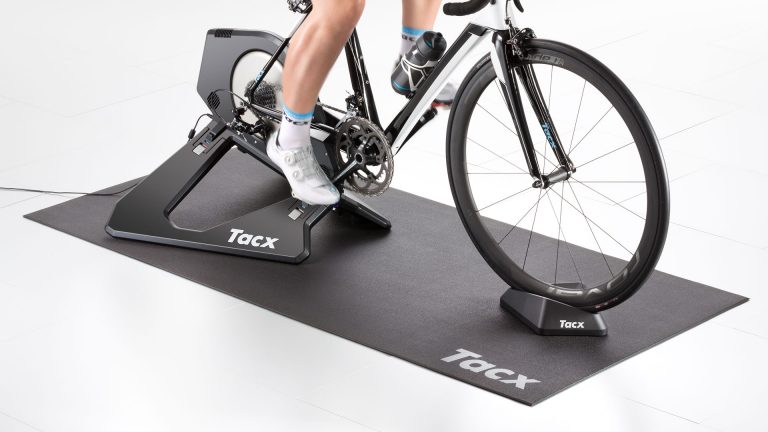
A hit for the Tacx trainer fans out there, this rollable mat can hold its own with any competitor.
At 0.25″, it’s thicker than most models, helping it last longer, dampen noise and offer greater protection. The foam rubber material is water-resistant, making cleaning simple and quick with an easy wipe-down.
The tough material is flexible enough to be easily and quickly rolled up for storage. Between that and the durable foam, you should find yourself cutting noise and saving your floors for a long time to come.
- Pros : Easy to clean and wipe down. Wide and thick, suitable for heavier smart trainers.
- Cons : Be prepared to open up the wallet for this.
Kinetic
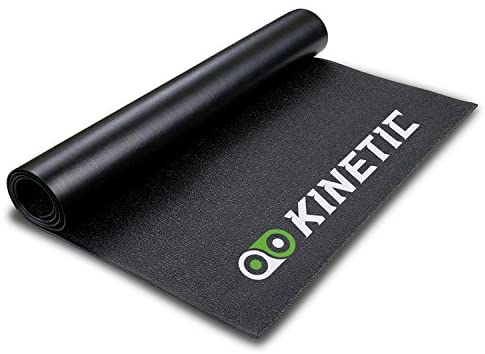
Kinetic by Kurt is one of the more innovative companies working on trainer technology these days, so it makes sense that they’d come up with a terrific mat to go with their trainers.
Made from tough closed-cell PVC, it’s unusually thick at 0.5″, yet supple and flexible enough to roll up as easily as a yoga mat.
It covers a lot of ground at 72″ x 36″, and at 8 lbs, it can stand up to the toughest pressures and the most intense workouts.
- Pros : Very thick at 0.5″, yet supple compared to its peers, but easy to fold down for storage.
- Cons : Have an odor when its new.
Blackburn
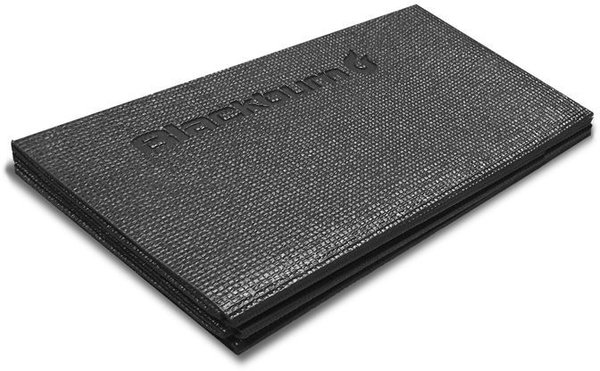
Blackburn, a producer of excellent cycling and training accessories, has brought a solid offering with their folding mat. A lot of us city-dwellers know the pain of making do with constricted living space, and Blackburn is a perfect solution.
The standout feature is it folds up sectionally rather than rolling up, making it incredibly easy to store in a closet or carry while traveling. This allows you to protect your floors, deaden noise and capture moisture and dirt with ease and without taking up excessive space.
- Pros : Reasonably priced and folds up easily for storage
- Cons : Thinner material compared to the other models.
Why You Should Use Trainer Mats
For many who ride indoors a lot, the mat is one of the most important and first pieces of indoor cycling accessories they buy.
Not convinced why you should use a trainer mat?
Here are 3 reasons that will hopefully convince you otherwise.
1. Noise Reduction and Vibration Damping
Any bike trainer will produce noise when in use, and while that might be fine on the road or in the gym, it’s not what your family or neighbors asked for.
The best trainer mats are the ones that help dampen and disperse sound and vibration.
This is achieved in a couple of ways, namely, type of material used and its thickness.
Lighter, softer materials won’t be as effective as heavier ones for reducing either vibration or noise.
For example, if you try to skimp and buy a yoga mat instead of a dedicated trainer mat, you’re going to end up annoying people around you and wasting money because these thinner, lighter mats don’t have what it takes to absorb the noise of your trainer.
Using a trainer mat to cut sound will help a lot if you have neighbors who live in homes above or below you, especially with flooring materials like wood or linoleum. It’ll also help you cut distracting whirring and buzzing while you’re on your bike, so you’ll enjoy your ride and be able to focus better for longer.
2. Floor Protection
This is crucial whether you own or rent.
Good quality flooring isn’t cheap, and neither are repairs. If you try using a trainer without the proper mat as a foundation, you’re almost certain to be kicking yourself soon afterward for having made preventable scuffs, scrapes, scratches, and cuts on the floor.
Trainer mats also catch grime, dust, water, and sweat.
Not only does this stop these substances from staining your floor or leaving unsightly marks, but it also provides you with a secure, grippy surface to step onto once you’re finished with your ride.
3. Ease of Cleaning
One of the key distinguishing features of a trainer mat from ordinary foam padding or a yoga mat is its water impermeability.
This means that a proper bike mat will both catch moisture while not absorbing it.
Luckily for you, this has a few different benefits.
For one, you definitely don’t want something that smells like old sweat hanging around your home, even if it’s just left out in the garage. Lingering sweat smells are unpleasant, unhealthy, and a turn-off for friends, family, and neighbors.
But it’s not just about hygiene.
Investing in and laying down a sturdy trainer mat also eases and speeds up your cleanup at the end of a workout, having caught much of the grime or moisture that’s sure to rain down during your ride.
Trainer Mats Buying Guide
A good quality trainer mat will save you time, money, energy, and headaches.
Once you’ve learned that these are not your average padding and they need to be taken seriously, it’s important that you keep in mind several key qualities when purchasing one.
Here are 4 important things to know before buying trainer mats.
1. Materials
Generally, trainer mats are made from either one of these materials below. Let’s take a deeper look into each of them.
- Polyvinyl chloride (PVC) is one of the most durable and popular plastics globally, used for everything from industrial insulation to clothing. PVC is prized for its strength, resistance to tearing, and water resistance. The heavy plastic also grips firmly and reduces the chances of shifting and sliding while you’re on your trainer. The main drawback is the smell. Fresh PVC has a distinct odor, which can be unpleasant or overpowering for some, although it gradually dissipates after a few weeks.
- Rubber foam is a trendy choice for its low cost, wide availability, and ease of cleaning. While rubber tends to be softer and less long-lived than PVC, it can also be crafted into remarkable tough mats like the Tacx rollable mat. Most rubber mats are pleasantly squishy and have many giving to them, so they’re a good choice for smaller riders and lighter bike trainers.
- Vinyl composite is one of the toughest materials around, popular as a source of sure-footed floor covering for highway construction crews and oil field workers. With a vinyl composite mat, there’s absolutely no way you’ll find yourself skating across the floor as you pump your legs. The solid, streak-free substance also means you’ll have less to worry about when it comes time for cleanup.
2. Dimension
Most trainer mats are sized to accommodate the footprint of a mounted bike and little else.
This is good news for those of us with limited floor space, but riders who tend to be a little more expansive will either need to practice minding their movements or invest in some additional matting.
Make sure to get a rough measurement of how much floor space you take up with your full set-up.
While most mats measure 2 to 3 feet in width and about 6 feet in length, you’ll want to be sure that you get adequate coverage before you lay your money down.
3. Thickness
The rule of thumb is the thicker, the better. Unless the thickness will really get in the way of storage, it’s better to hedge your bets.
A thicker mat will stand a better chance of protecting your floor and catching moisture and dirt.
Besides that, the thicker the material, the heavier it is, which means you won’t have to mess around trying to get it to lie flat.
On the other hand, thinner mats will be easier to store, but they’ll require a bit more attention and care to get good use out of them and make them last.
4. Ease of Cleaning
Everyone knows that your work isn’t done at the end of your ride. Cleaning up your gear helps it last longer, helps you relax in your space, and cuts down on annoying those who live with you.
Most trainer mats are made of non-absorbent material that can easily be mopped off, vacuumed, or wiped down.
Avoid textured surfaces or crevices, because these are more likely to catch bits of unhealthy substances and produce unpleasant smells.
Author Recommended Reads


